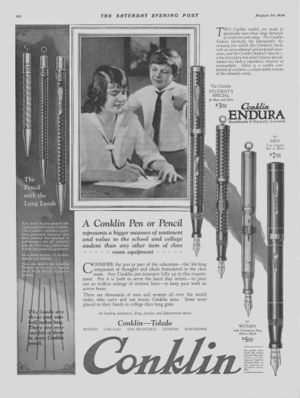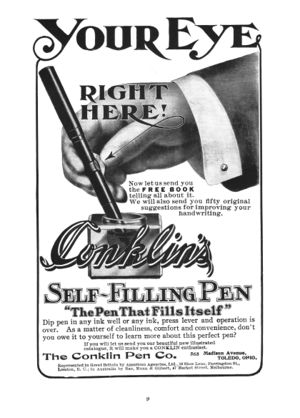Conklin/en
Conklin was officially founded in 1898, but its founder, Roy Conklin, had been in the fountain pen business since 1891. The success of the company was mainly due to the invention of the Crescent Filler, the first really functional automatic filling mechanism. But after its initial period the company underwent a gradual decline, completely ceasing production around the '50s. The brand was recreated in 2000 with the production of pens that reflect the design of the old models.
The Conklin had the maximum of its success at the beginning of the '900, when it became the market leader thanks to the Crescent Filler, but was not able to keep up with competitors in subsequent innovations, and although in the subsequent years it produced pens of undoubted value and excellent quality, still much sought by collectors, success the company was no longer been able to innovate, gradually losing market share and remaining constantly behind the Big Four.
| Conklin |
|---|
| Brand pages |
| Brand advertising |
| Brand photos |
| Patents |
History
The Conklin Pen Manufacturing Co. was officially born with this name in Toledo, Ohio, in 1901, but the company was founded by Roy Conklin as Self Fountain Pen Co. in 1898 together with C. B. Gundy. The previous year Roy Conklin had registered the patent for the first working automatic filling system created for a pen.
The company strong initial success was due to the creation of the Crescent Filler, which was the first automatic filling mechanism truly reliable. These firsts models were made in chased hard rubber like other pens of the same period, but their innovative filling system led the company at the top of the market. In 1904, Roy Conklin withdrew from company selling all its shares, after that the ownership passed hands several times. In this golden period Conklin followed a policy of trade expansion, with vigorous promotional campaigns, exporting even in Europe and South America.
In 1916 Conklin introduced an innovative spring clip, that can be open very easily; for its simplicity and elegance the same mechanism has been used today by modern companies like Visconti. The sales of fountain pens, although declining, remained at the top of the market, also if Conklin models become to be considered a little dated.
In fact, although functional and efficient, the Crescent Filler had its worst flaw in being unpleasant from an aesthetic point of view, and despite a strong promotional campaign that emphasized its merits (Mark Twain, taken as testimonial, endorsed the advantage of it not allowing the pen to roll down from the table) with the appearance of lever filler pens the sales began to decline increasingly, despite that the new mechanism was inferior from a purely technical point of view.
This is why in 1921 also Conklin started producing models with a peculiar lever filler mechanism, ingeniously constructed so that only half of the lever was in the open. With the introduction of the large dimension pens trend started by the Duofold also Conklin introduced in 1923 the Duragraph model. The following year the Duragraph was renamed as Endura and the production was converted to celluloid. Initial model were in black or red hard rubber, but soon they were produced in celluloid, with different colors like Rosewood, Black & Gold, Lime Green, Lapis blue and the rare Blue & Gold.
L'Endura era il modello di punta dell'azienda, portando il nome inciso sul corpo e sul pennino. Venne prodotta in tre misure, una versione da taschino corta, una misura standard e la senior. A fianco di essa l'azienda introdusse una serie di penne economiche per studenti, con la stessa forma ma in unica dimensione pari al modello standard, che vennero prodotte in colori pastello a tinta unita.

A questo punto l'azienda però non era più un leader di mercato, ma si limitava a seguire quanto fatto dagli altri. Un esempio di tutto questo è l'introduzione, fra il 1929 ed il 1930,[1] del suo primo modello streamlined, la Symetrik, seguendo la moda lanciata dalla Balance della Sheaffer. Le vendite risultavano in costante declino e l'azienda subì pesantemente gli effetti della grande recessione. Intorno al 1930 iniziò anche la produzione di una linea di penne economiche sotto il marchio All-American.
L'ultimo modello di punta della Conklin è stata la Nozac, disegnata da Louis Vavrik ed introdotta nel 1931, unica penna americana dotata di caricamento a stantuffo, dotata di serbatoio trasparente e grande capacità di inchiostro (ulteriormente sottolineata, a partire dal 1934, dall'introduzione del word gauge, una scala che misurava il numero di parole restanti). La penna, con i suoi bellissimi colori ed il corpo sfaccettato, resta uno dei vertici della produzione di quel tempo, ma il meccanismo, essendo stato ripreso da quello di una matita meccanica, non era particolarmente robusto ed efficiente e la penna non ebbe il successo che avrebbe meritato. Nel 1937, praticamente per solo un anno, venne prodotta una versione con caricamento a siringa rovesciata denominata One Stroke.
L'azienda perseguì nel suo declino e nel 1938 tutti i beni della Conklin vennero ceduti alla Chicago Interests. L'anno successivo gli impianti di Toledo vennero chiusi e la produzione venne spostata a Chicago. I modelli precedenti rimasero in produzione ma durante la guerra vennero prodotte poche penne. In seguito la produzione continuò a spostarsi su penne sempre più economiche e di fascia bassa, per finire con una penna a sfera di basso costo. Benché alcune di queste penne, come la Glider, restino di interesse collezionistico, la produzione della Conklin si ridusse progressivamente di qualità e quantità, per cessare completamente nel 1948 (o 1955?).
Ad oggi, come accaduto per molti altri marchi storici, la Conklin è stata rifondata ed opera dal 2000 come Conklin Pen Co. Inc., le sue penne (stilografiche e non) sono sostanzialmente delle repliche dei modelli di successo degli anni d'oro, e come per la maggior parte delle penne moderne, non hanno nessuna qualità particolare che le distingua rispetto alle penne d'epoca.
Template:CronoMarche |- | 1897 || Roy Conklin brevetta il crescent filler |- | 1898 || Roy Conklin fonda la Self Fountain Pen Co |- | 1901 || La Self Fountain Pen Co diventa la Conklin Pen Manufacturing Co |- | 1903 || Una aggressiva campagna pubblicitaria vede protagonista Mark Twain |- | 1916 || Viene brevettata la caratteristica clip a molla |- | 1921 || Introdotti i primi modelli con caricamento a levetta |- | 1923 || Viene introdotto il modello Duragraph |- | 1924 || Viene introdotta la celluloide e la Duragraph diventa la Endura |- | 1925 || Viene dismesso il crescent filler |- | 1929 || Viene introdotto il modello Endura Symetric (o 1930?) |- | 1929 || Viene ritirato il modello Endura classico (o 1930?) |- | 1930 || Introdotta la linea economica All-American |- | 1931 || Viene introdotto il modello Nozac |- | 1934 || Sulla Nozac viene introdotto il Word gauge |- | 1937 || Viene introdotto il modello One Stroke |- | 1938 || Viene introdotto il modello Glider |- | 1938 || Gli impianti di Toledo chiudono e la produzione si sposta a Chicago |- | 1948 || La Conklin chiude la produzione |- |}
Template:LegendaModelli |- | Endura || 1924 || |- | Nozac || 1931 || |- |}
Note
- ↑ da diverse fonti sono riportate entrambe le date.

